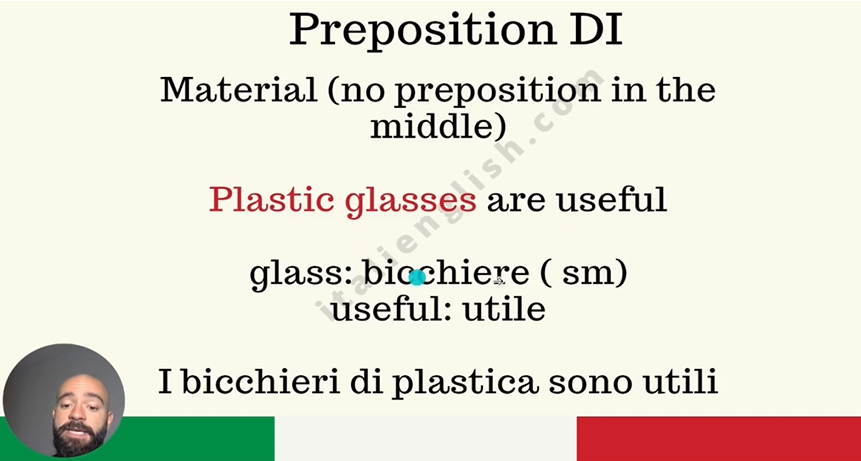Italian grammar, with its intricate web of verb conjugations, gendered nouns, and nuanced prepositions, can be quite a labyrinth for language learners.
One of the most crucial aspects of mastering Italian is understanding the various uses of prepositions, and today, we're embarking on a journey to decode one of these prepositions - "di."
Content
Content
Demystifying the Preposition "Di" in Italian
"Di" is one of the fundamental prepositions in Italian, and it plays a multifaceted role in the language.
To navigate the Italian linguistic landscape successfully, we need to explore its various applications, from indicating possession and material to addressing topics and origins.
Possession: Italian Preposition "Di" as the Guardian of Ownership
Possession is the first territory where "di" takes center stage. Imagine you want to express the possession of an item, say a computer, by a person named Philippe.
In English, you would say, "This is Philippe's computer." In Italian, you can rephrase it as "Questo è il computer di Philippe."
Notice the use of "di" here. It acts as the bridge between the possessor and the possessed object, much like the English possessive 's.
However, it's essential to remember that not all prepositions have such straightforward translations, as we'll discover further.
Material Matters: "Di" Unveils Composition
Now, let's pivot to the realm of materials. If you want to convey that something is made of a specific substance, like saying "This table is made of wood," you would use "di" in Italian.
The translation would be "Questo tavolo è di legno."
However, there's another scenario to consider: when you want to describe an object by stating its material without explicitly mentioning "made of."
For instance, consider "plastic glasses." In this case, "plastic" describes the material of the glasses
Here, "di" might take a back seat, and the translation becomes "Gli occhiali di plastica sono utili" (Plastic glasses are useful).
Do you like what you've read so far? Wanna grab a FREE 4-videos series? Subscribe to my newsletter!

I'll notify you of new articles and send exclusive content. Don't worry! No spam, no unwanted emails, and no sharing your data with third parties.
Delving into Topics: The Italian Preposition "Di" in the World of Subjects
The versatile "di" also plays a crucial role when it comes to topics. If you wish to describe a book as a geography book, you would say "Questo è un libro di geografia."
The "di" here signifies that the book pertains to the subject of geography.
But wait, there's more to the topic scenario.
When you want to express discussing a particular subject, especially when using the verb "to talk," "di" steps in as the preposition of choice.
For example, "I want to talk about dinosaurs" translates to "Voglio parlare dei dinosauri."
Here, "di" connects the verb "parlare" (to talk) with the subject "dinosauri" (dinosaurs).
Unraveling Origins: "Di" and the Sense of Belonging
Lastly, let's explore the concept of origin, a use of "di" that you don't want to confuse with movement from a place. When you want to say you are from a specific city or location, "di" is your go-to preposition. For instance, "I am from Venice" becomes "Sono di Venezia."
The Complex World of Italian Prepositions
As we've seen, "di" in Italian is not a one-size-fits-all preposition.
Its usage varies depending on context, which can be both fascinating and daunting for Italian learners.
§It's crucial to refrain from making sweeping assumptions about prepositions, as you might find yourself in a linguistic tangle.
Italian prepositions often have unique usages that require memorization.
In the case of "di," we've explored its roles in possession, material composition, topic discussion, and indicating origin.
Each of these contexts demands a nuanced understanding to wield "di" effectively.
To recap, here are the primary contexts where "di" shines:
- Possession: Use "di" to express ownership, much like the English possessive 's. Example: "Questo è il computer di Philippe."
- Material: "Di" helps describe the composition of an object. Example: "Questo tavolo è di legno."
- Topic: Employ "di" to connect a subject to a noun, especially when talking about a specific subject. Example: "Questo è un libro di geografia."
- Origin: When indicating where you're from, "di" plays a vital role. Example: "Sono di Venezia."

Conclusion
Learning the intricacies of Italian prepositions is a rewarding but challenging journey.
Di," with its multifaceted uses, exemplifies the complexities of the Italian language.
By understanding its roles in possession, material composition, topics, and origins, you're taking a significant step toward mastering this beautiful language.
Remember, the key to success in learning Italian lies in practice, patience, and a keen eye for context.
Don't hesitate to reach out if you have questions or need further clarification.
Buona fortuna (good luck) on your Italian language adventure!
Do you want to get access to my Italienglish Mentoring Program?
13+ hours of video library, daily assignment, accountability, live calls and private Facebook group.
In 3 months you WILL be able to speak Italian, it's a promise!

Comments are closed!